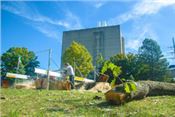|
Old Tree Finds New Life In A New Form

Branch and Bark Urban Sawmill milled a red oak tree on campus as a demonstration during
National Forest Products Week.
Photo by Matt Barton
LEXINGTON, KY.
Urban life can take its toll on a tree. Pollution, trenching to lay underground utility lines, soil compaction, it’s all very hard on an old tree, and the red oak tree in front of the Agricultural Sciences Building on the University of Kentucky campus had seen better days. But its story won’t end in piles of mulch. Instead, its wood will find its way into useful, beautiful objects created by and for UK students, faculty and staff.
That the oak, which had died on the side facing the building, will live on through other products is a good illustration of the many products that come from forests – more than 5,000 in fact, said Chad Niman, primary forest products specialist in the UK College of Agriculture, Food and Environment. Forest products range from the mundane to the sublime, such as toilet paper, lumber, food, medicines and musical instruments.
“We can salvage and use these large trees and make them into something better than just mulch,” Niman said. “It’s exciting to see that material used in something longer lived.”
In this case, the old red oak is destined for greatness in two UK colleges. The College of Agriculture, Food and Environment will set aside some of its wood for future projects. And the College of Design has plans to use it in a number of ways. Students will design and build with it in the furniture design studio. Bruce Swetnam, associate dean for students in the College of Design, said they are also considering it for an art piece milled for their new café space.
Just as it took a long time for the oak to grow to its mature 39-inch diameter, its lumber will not be ready overnight. Niman’s team is going to air dry the squared and live edge lumber and monitor the moisture level, which will avoid or greatly reduce the cost of kiln drying. That means the wood will likely not be available for about two years.
Stacy Borden, UK arboriculture superintendent, worked closely with Niman in arranging for the harvesting and milling of the tree. Borden has created a tree protection standard for the university. If a tree has to be removed, the replacement policy is an inch-for-inch replacement.
“It takes a long time to replace that tree’s canopy, so replacing a 60-inch tree with one 2-inch tree doesn’t even come close to replacing the canopy or the benefits from that canopy,” he said. “We can replace that canopy a lot faster if we plant 30 2-inch trees.”
Aside from the aesthetic value, Borden said preserving the tree canopy is about stormwater mitigation. A tree’s canopy will intercept the rain before it hits the ground, either absorbing it, allowing it to evaporate back into the atmosphere, or letting it drip down at a much slower pace, which gives the soil more time to absorb it.
“There’s a lot of stormwater that never even gets to the storm drains because of a tree’s canopy,” Borden said. “If we start losing all this canopy, all of a sudden we have a lot more stormwater and surface flows and erosion, which means more pollution.”
Branch and Bark Urban Sawmill contributed their time and equipment to mill the oak once the tree was down. With two sawmills they brought to the site, they milled planks from some of the smaller diameter pieces and cut six thick slabs from the main trunk.
“One of the things we’re trying to achieve is the salvaging of these logs,” Borden said. “In the past, they went to the city’s composting facility and turned into mulch. We’re trying to divert our wood away from that, because there’s better use for the wood.”
The plan going forward is to turn trees that can’t be saved into a usable form that could benefit the university in some way.
“This material from the campus trees can provide unique learning experiences, fill material needs for classes and programs, and have folks thinking about stewardship and utilization,” Niman said. ∆
|
|